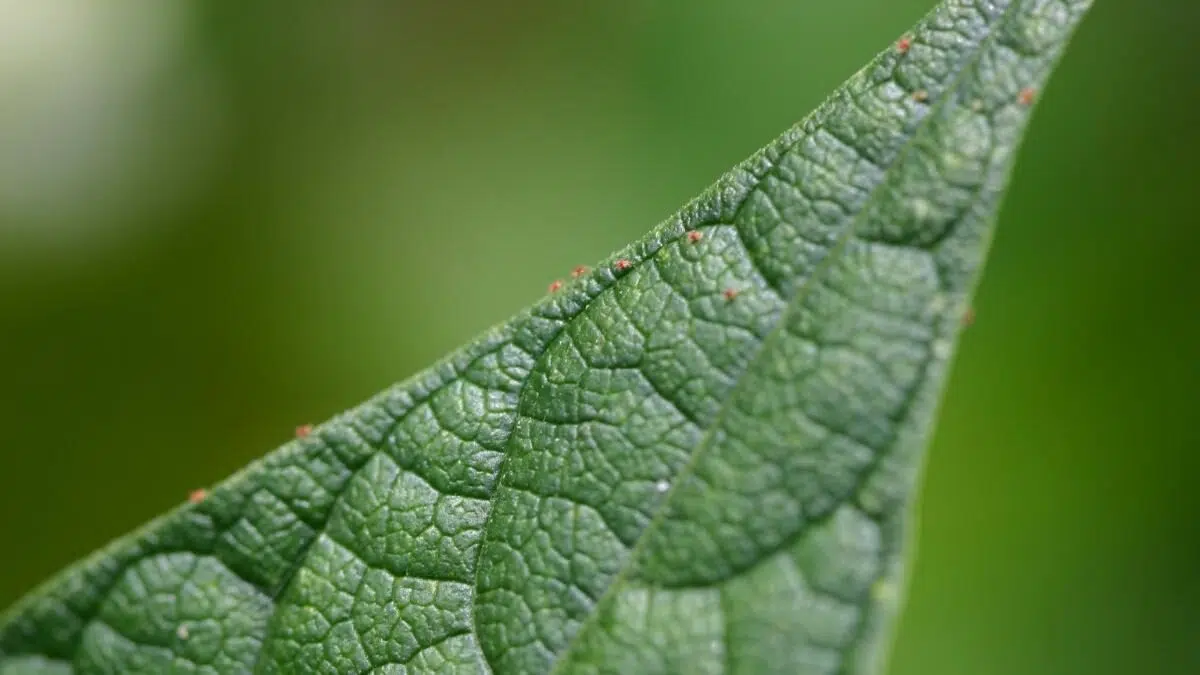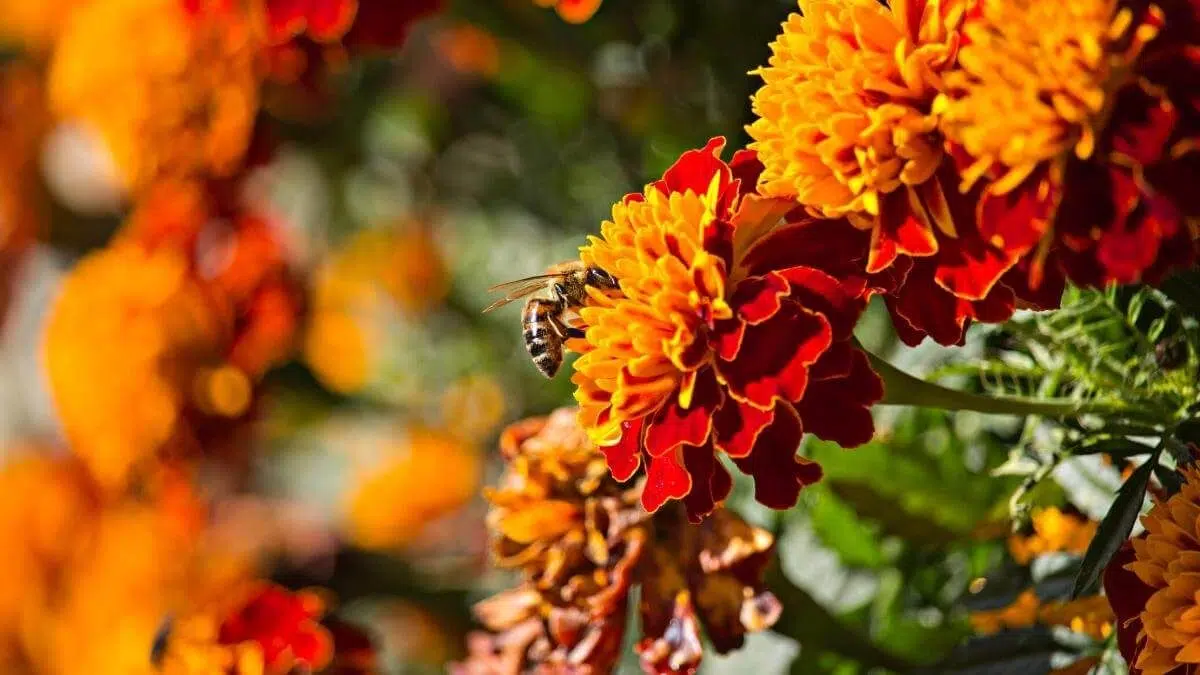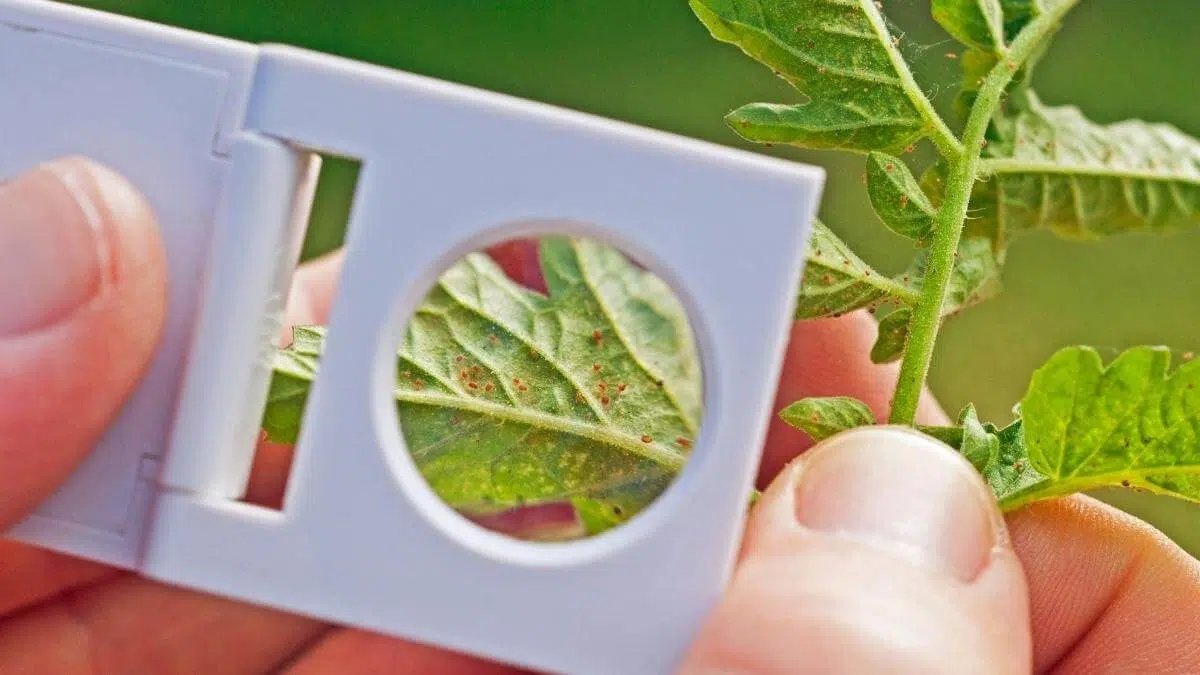Last year was the first time I experienced a lot of spider mite damage on some of the plants in my garden. Let me tell you, it’s not fun.
I went on a mission to figure out how to get rid of spider mites on marigolds and keep them from coming back. Let’s get into it!
What Are Spider Mites?
Spider mites are very small red bugs (i.e. arachnids) that are reddish-orange color as adults and green color as nymphs. They originated in South America, but are now found all over the world (fun!).
Spider mites usually peak during the early summer, and they thrive in the hot and dry weather which is when their populations seem to explode. They are hard to get rid of because they can move around via wind, water, and on the clothes of gardeners and farmers.

They create these massive nests on plants and the infected leaves will eventually turn yellow then brown, and die.
There are a few different types of spider mites you can find on your marigolds. Most species can be taken care of the same way, so if you identify spider mites on your plants, these methods should work well.
Using Marigolds as a Sacrificial Plant
Before we talk about ways to eliminate spider mites, did you know that some people plant marigolds as sacrificial plants because they attract pests like spider mites and aphids?

One example of this is planting marigolds and tomatoes together. Tomato plants can get ravaged by spider mites, so planting marigolds nearby can attract them to the flowers instead of tomatoes.
You can plant marigolds to attract spider mites and save some of your other plants that are generally affected by them like:
- Mint
- Basil
- Rosemary
- Pepper plants
- Strawberries
- Houseplants/Indoor Plants
While these aren’t the only plants affected by spider mites, they are some of the common ones.
The ability for them to attract spider mites makes marigolds a great companion plant for lots of other garden plants.
How to Get Rid of Spider Mites on Marigolds
If you already have an issue with spider mites, let’s walk through a few ways to repel spider mites and salvage your healthy plants.
1. Spray the Leaves With Water
One of the best ways to help control a spider mite population is by spraying the leaves with a strong stream of water. This can knock them off the plant, but make sure you don’t spray them onto nearby plants as this will just move the problem.
However, this can be tough with marigolds, especially if they’re already started flowering.
If you’re going to use this, make sure you spray the underside of the leaves as well because this is where spider mites will lay eggs and can hide.
2. Neem Oil
Neem oil is another option for helping to control spider mites and it is my favorite. Unlike some other options, neem oil can attack eggs and larvae as well as adults, so it’s more effective on a broad scale.
Organic neem oil is an effective remedy for controlling populations, even after the initial application as the oil can get into the soft-bodied insects and cause damage.
You want to reapply about every 2 weeks, but that’s a lot less than some other methods of controlling mites.
3. Horticultural Oil & Soaps
Ultrafine horticultural oil sprays can be effective for removing spider mites on contact, but make sure to thoroughly spray the plants as they work on contact. Apply in the morning, or when the weather does not get above 75 degrees Fahrenheit.
Horticultural oils and soaps are a great option, but just know that once these dry they don’t help at all, so it’s really the initial contact with the pests that will kill spider mites.
These don’t work for getting rid of spider mite eggs, so you want to re-apply the treatment after 2-3 days once those eggs have all hatched.
4. Hot Pepper Spray
You can also make a hot pepper spray to spread around the leaves and underside of leaves as this will kill many of the mites. Add about 80g of cayenne pepper or chili powder to a gallon of water (or 20 grams to a liter) and spray the plants thoroughly.

5. Introduce Predatory Insects
There are some insects that will feed on two-spotted spider mites, and by introducing these to the garden you can help keep the damage to a minimum.
Predatory mites (T. pyri) similar to the pesky mites, but they are good at controlling spider mite populations. Lady bugs (Stethorus punctum) are also natural enemies of spider mites. Thrips and lacewings are other great controllers of spider mite outbreaks.
5. Diatomaceous Earth (But….)
Diatomaceous earth is a powdery substance that I loved when I first started gardening. It is effective at removing a lot of pests you don’t want in your garden.
The great thing is that food-grade versions of this are non-toxic to humans. But the bad thing about diatomaceous earth is that it can also kill beneficial insects like ladybugs, lacewings, butterflies, and the coveted honeybee.
Not only are these generally beneficial in the garden, but they are some of the natural predators of the spider mite, so you don’t want to harm them as it could increase the infestation instead of having the opposite effect.
I no longer use diatomaceous earth in the garden because of this.
How to Prevent Spider Mites
Preventing spider mites in the first place is important for reducing the annoyance of these pests taking over your marigolds.
Check Your Leaves and Flowers Regularly
Mites usually start appearing on the lower leaves of plants, working their way up as they need more space. This is a great place to start your search when you check for spider mites. The underside of leaves is where you’ll initially find them on your plants.
They are difficult to see with the naked eye, but you can usually find them by looking for webbing on the flowers.

While they can be hard to see with the human eye, you can use a magnifying glass or small hand magnifier to check the leaves for spider mites.
Remove Infested Plants After Harvest
If you had a spider mite infestation during the garden season, make sure you’re getting rid of those crops completely. You can burn them, or find other creative ways to destroy them, but don’t put them in the compost pile.
Spider mites can overwinter and will come back next year, so marigolds with spider mite infestations should be destroyed to prevent the spread of the pests.
Control Weeds in the Garden
Weeds are the bane of any gardener, and while it’s an annoying job, it’s super important to keep them at bay because they house many pests, including spider mites. Weed management is said to reduce the risk of them overwintering and traveling throughout the garden.
Solanum Nigrum, or black nightshade, is a regular host for spider mites, so if you have these in the garden, it’s important to keep them under control.
Frequently Asked Questions About Spider Mites
Do Spider Mites Lay Eggs in the Soil?
Female mites will overwinter in plant debris and fallen leaves, so it’s important to clean up the garden after the season is over.
Do Spider Mites Hurt Marigolds?
Spider mites can severely damage a marigold plant if left unchecked. You will start to see white or yellow spots on your plants, and eventually, the leaves will begin to die. Spider mites feed on chlorophyll in the cells of the leaf, which is what causes those discolored spots in the first place.
Once the population grows enough, you’ll start to see the webbing around the leaves and you’ll know your spider mite problem is a little more serious.
Using neem oil or spraying your leaves when you find a spider mite feeding on your plants can help mitigate the damage to a population.
Do Marigolds Attract Spider Mites?
Marigolds do attract spider mites, which can be a great way to keep these pests from impacting your prized vegetable plants.
Aside from aphids, spider mites are some of the most common garden pests you might come into contact with. Controlling spider mites is important, but sometimes people plant marigolds to purposefully attract them to the flowers instead of their fruits and vegetables.


